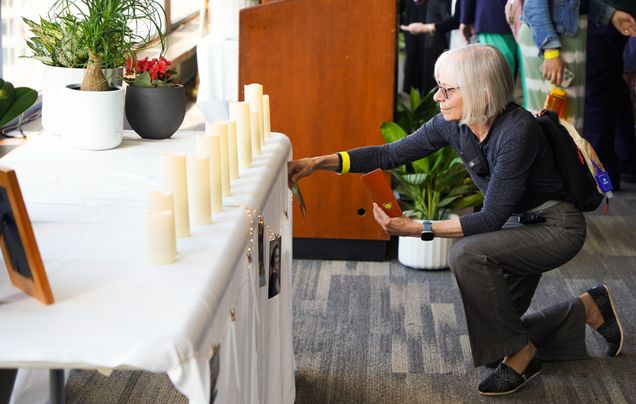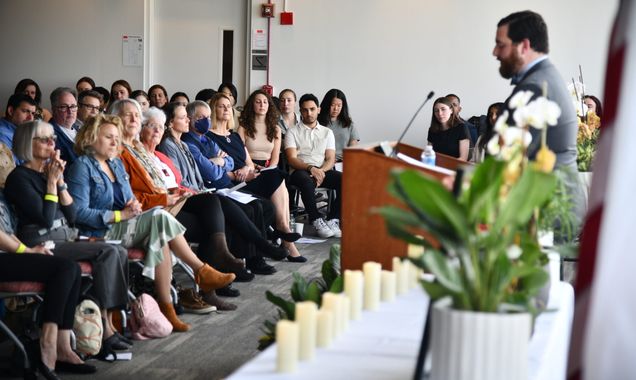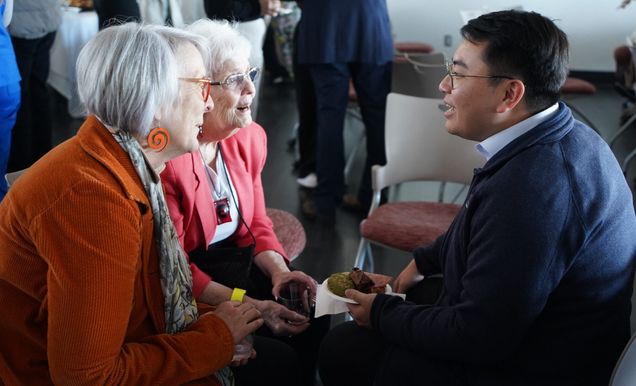Students Honor Anatomy Donors with Testimonials, Music and Poetry
 Paula Faist kneels to look at photo of her father at the anatomy donor memorial service.
Paula Faist kneels to look at photo of her father at the anatomy donor memorial service.
In an afternoon of songs, music, poems, prose and food, anatomy students celebrated and honored those who donated their bodies to medical education and their families, with a memorial service held May 3 in Hiebert Lounge.
“We should always remember and honor their sacrifice, and the sacrifice their families made in supporting their decision to donate their bodies,” said Sophie Gray, a first-year medical student, speaking to the audience of donor families, students, faculty and staff. “As students we will strive to continue their legacies, by using the knowledge and skills we have gained, by learning from the donors, to make a positive impact on the world.”
Each year, approximately 45 donor bodies are required for instruction of 310- 370 medical, dental, physician assistant and graduate medical science students studying in the Gross Anatomy Lab. The ceremony honored 23 donors whose bodies were studied in anatomy courses that had ended for the past academic year; 77 family members were present among the audience of 200.
“The donors came from all walks of life, but what united them was their selflessness,” said Gray.
“I have lived inside this amazing creation for 91 years,” one of the donors wrote in a letter to students. “How I envy you the opportunity to learn and figure it all out.”
Nancilee Fuller signed on as a donor in 1990. She loved to garden, worked as a restaurant and office manager, and for 20 years as a medical secretary in her local hospital, finally retiring at 80. Fuller was a member of a synchronized skating team until she was 75.
“She just loved being in the medical environment and always knew she wanted to contribute her body to science and further medical knowledge,” said her daughter Heidi Finnegan.
“I didn’t realize how emotional this would be for me,” said Finnegan, who teared up when she saw her mother’s photo and heard first-year medical student Aaron Ramtulla sing one of her mother’s favorite Adele songs.
“I wanted to show my appreciation for these people, these families and the donors,” said Ramtulla.
When students first open the body bag containing a donor, Jonathan Wisco, PhD’02, associate professor of anatomy & neurobiology, asks the students to gently place their hands on the donor.
“This is the first time they have experienced the gift of death, so that they can learn how to preserve life,” said Wisco.
“As soon as I saw the body, I felt this immediate sense of honor; the fact that I had the opportunity to…learn from them,” said Ramtulla. “I was overwhelmed with those feelings.”
A little over 20 years ago, the end of anatomy classes for the school year was marked with a moment of silence before students zipped up the donor bags for the last time and the bodies were sent to the crematorium. But Robert Bouchie, manager of the gross anatomy lab and director of the anatomical gift program, said students wanted more, and the memorial evolved into a non-denominational, student-run ceremony that over the past decade also has included donor families.
 Giulio Cataldo, a first-year medical student who helped organize the donor memorial service, speaks to donor family members, students and faculty.
Giulio Cataldo, a first-year medical student who helped organize the donor memorial service, speaks to donor family members, students and faculty.
First-year medical student Giulio Cataldo is one of 14 students on the ceremony’s organizing committee. He said meeting the donor families at the ceremony completes the circle that began when they were introduced to the donor bodies and learned about their lives through the physical manifestations – such as an enlarged heart, gall stones, overdeveloped muscles on one side of their body – that the bodies accumulated during life. The families help them reunite the body with the person who inhabited it.
“We get to know them very intimately and personally, seeing their internal organs and hearing about their past medical conditions,” said Cataldo. “We were really looking forward to meeting the families. I’m excited to hear the stories about their loved ones.”
“I like that (the ceremony) is student-driven,” said keynote speaker Monica Pessina, PhD‘05, clinical associate professor of anatomy & neurobiology. “I think the families are very touched…You hear about the value of the body donation, but they see it and feel it from the students who are there.”
 First-year medical student Keven Cheung talking with donor family members Julie and Mary Todd.
First-year medical student Keven Cheung talking with donor family members Julie and Mary Todd.
Jim Todd was a United Methodist minister. In his life he was an advocate for peace, social justice and LGBTQ+ inclusion in the church. He and his wife Mary, who attended the ceremony, decided to donate their bodies to BU nearly 30 years ago.
Todd was known for his affection for the children’s song, “Hokey Pokey.”
“You put your whole self in, and that’s what Jim did,” said Mary Todd.
“The music was just absolutely beautiful. It was a wonderful service that I felt truly healed by,” said Todd’s daughter Julie. “He would have loved every minute of it.”
The program included an opportunity for the donor families and students to meet and talk over food. Keven Cheung, a first-year medical student, sat with the Todds.
“Hearing what kind of man he was really touched me because of the things he was fighting for,” said Cheung. “Connecting with them…makes me appreciate the gift that much more and makes me realize that every one of the donors had decades of life and experiences; things they fought for, hopes and dreams; and that they live on in the people they knew, in their families, and in us.”
At the close of the ceremony, the donor families privately receive their loved one’s cremated remains. Bouchie personally delivers them to families who can’t attend the service.
“I can’t wait to bring her home,” said Gillian Sanders of her mother Doris Sanders, who will be reunited with her husband Charles, who also donated his body eight years earlier. The two had met in Germany during WWII. She was German and he was an American soldier. Gillian attended the ceremony with her brother Michael.
“We were waiting for my mother, to take them both back to Germany, and sprinkle their ashes there,” said Sanders.
View all posts